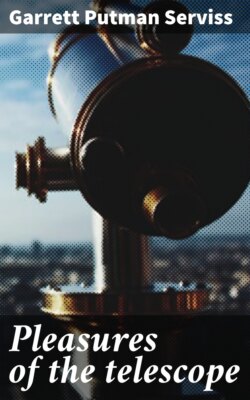Pleasures of the telescope

Реклама. ООО «ЛитРес», ИНН: 7719571260.
Оглавление
Garrett Putman Serviss. Pleasures of the telescope
Pleasures of the telescope
Table of Contents
PREFACE
CHAPTER I
THE SELECTION AND TESTING OF A GLASS
CHAPTER II
IN THE STARRY HEAVENS
CHAPTER III
FROM GEMINI TO LEO AND ROUND ABOUT
CHAPTER IV
VIRGO AND HER NEIGHBORS
CHAPTER V
IN SUMMER STAR-LANDS
CHAPTER VI
FROM LYRA TO ERIDANUS
CHAPTER VII
PISCES, ARIES, TAURUS, AND THE NORTHERN STARS
CHAPTER VIII
SCENES ON THE PLANETS
CHAPTER IX
THE MOUNTAINS AND PLAINS OF THE MOON, AND THE SPECTACLES OF THE SUN
The Sun
CHAPTER X
ARE THERE PLANETS AMONG THE STARS?
FOOTNOTES
INDEX
THE END
Отрывок из книги
Garrett Putman Serviss
An Illustrated Guide for Amateur Astronomers and a Popular Description of the Chief Wonders of the Heavens for General Readers
.....
THE END
The answer is, that the refractor gives more light and better definition. It is superior in the first respect because a lens transmits more light than a mirror reflects. Professor Young has remarked that about eighty-two per cent of the light reaches the eye in a good refractor, while "in a Newtonian reflector, in average condition, the percentage seldom exceeds fifty per cent, and more frequently is lower than higher." The superiority of the refractor in regard to definition arises from the fact that any distortion at the surface of a mirror affects the direction of a ray of light three times as much as the same distortion would do at the surface of a lens. And this applies equally both to permanent errors of curvature and to temporary distortions produced by strains and by inequality of temperature. The perfect achromatism of a reflector is, of course, a great advantage, but the chromatic aberration of refractors is now so well corrected that their inferiority in that respect may be disregarded. It must be admitted that reflectors are cheaper and easier to make, but, on the other hand, they require more care, and their mirrors frequently need resilvering, while an object glass with reasonable care never gets seriously out of order, and will last for many a lifetime.
.....